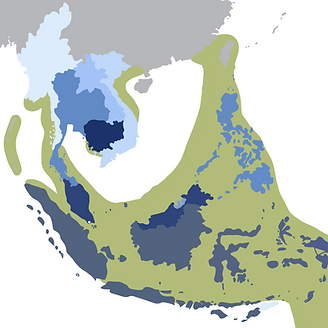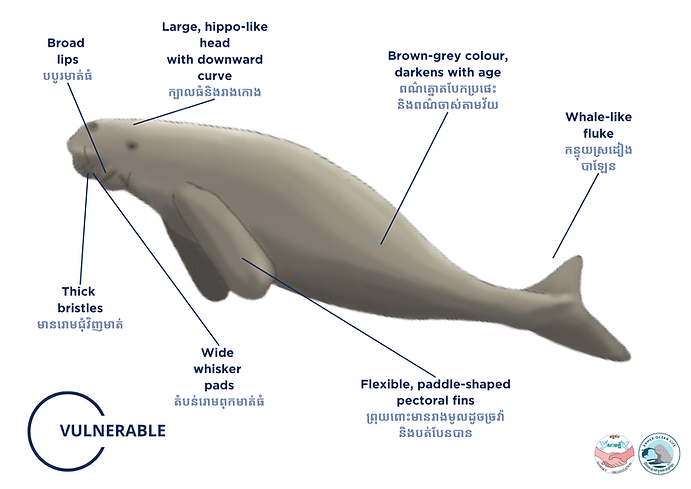Distribution
Found sparsely across a wide range of coastal areas: from South Africa and Madagascar through to the Red sea, Persian Gulf; all the way through SE Asia to New Guinea and Australia.
Shallow water whereabouts tend to depend on the tide and the time of day; shallow water grazing activity likely to be in the evenings during high water

Description
Large hippo-like downward curved head with wide whisker pads and chin covered with thick bristles
Nostrils are situated on top of snout with broad lips concealing the mouthline
Flexible paddle-shaped pectoral fins
Whale-like tail - key characteristic differentiating them from other sirenians
Generally bluish grey in colour, usually darkening with age becoming more scarred and covered with barnacles and algae

Behaviour and Ecology
Usually travel solitary or in groups of up to 6
Dive between 1-8 mins at a time, coming up to breath only exposing its nostrils - fluke partially exposed when planning on deep diving
Sexually mature at 9-10 years
Gestation lasts for 12-14 months and females can calf all year-round - calves can stick with mother for up to 7 years.
Main Threats
Seagrass Degradation
Loss of shallow water seagrass meadows due to coastal development, trawling and anchor scarring can cause malnourishment in local populations, preventing the cows from breeding
Bycatch and hunting
Often caught in gill nets in shallow waters
Hunting of dugongs is illegal in many countries; however, this is barely regulated in a lot of places
Click here to learn more about our
Boat activity
Dugongs are extremely vulnerable to boat collisions and susceptible to marine noise pollution, interrupting feeding and breeding cycles
Dugong vs. manatee
The Dugong (Dugong Dugon) and the Manatee (Trichechus sp.) are very similar in both appearance and their behaviour. Both Sirenians are related to eachother. Because of their large bodies but gentle nature they are also refered to as “sea cows”. But there is one main difference between the two species: The Fluke.


Dugong:
Whale-like fluke
manatee:
Paddle-like fluke
Fun facts
In the Philippines, Malaysia, Indonesia and parts of Thailand dugongs are believed to have once been beautiful women who - when captured, killed or beached cry - this is considered bad luck
"Dugong tears" were thought to have been an aphrodisiac and used in love potions in parts of Singapore, Brunei, Vietnam and Cambodia as well as East Africa and were historically sought after and hunted to extinction due to this property as well as being considered a luxury food across parts of these countries
The name for dugongs in many languages is often a synonym for "mermaid" and was believed to inspire folklore surrounding them
In Tambun cave Malaysia there is a 5,000 year old neolithic cave painting of a dugong, suggesting a historic relationship with dugongs


